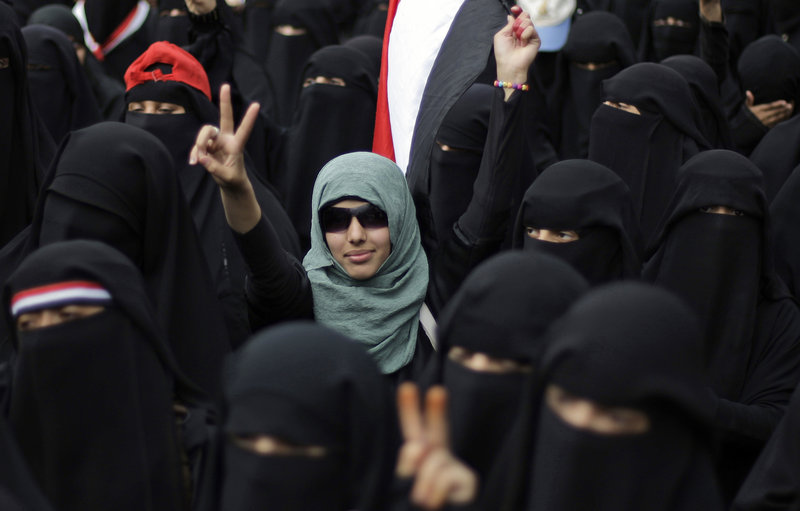SAN’A, Yemen — Early in Yemen’s uprising, about 20 women with banners demanding equal rights marched into the heart of the capital, joining the thousands who were calling for the ouster of the president. They were greeted with cheers.
The women settled into a spot below the stage in the middle of Change Square. But as the days passed, “the women’s section” became off-limits to men. A fence went up around it. Then straw mats were slung over the fence to conceal the women. Policed by bearded males, Yemen’s traditional gender segregation had insinuated itself into the center of the revolt.
Women are fighting to keep demands for their rights at the center of Yemen’s uprising. The main goal of the protests is an end to the regime of President Ali Abdullah Saleh, which has been in place for nearly 33 years. But the liberals who launched the campaign nine months ago have always had broader hopes for blanket social change in a country where tribe and religion dominate, no matter who is in power.
Women’s role in the uprising was recognized globally when Tawakkul Karman, a female icon of the protest movement, won the 2011 Nobel Peace Prize. But here in San’a, the reality is that every woman who joins the rallies has to rebel against the heavy pressure of social codes.
Women also face the growing influence of Islamic hard-liners at Change Square, as activists have named the intersection where they have set up their protest camp. Islamic movements are richer and better organized than the secular side. They dominate Change Square’s organizational committee and have attacked tents where men and women have gathered, seeking to undo the gender mixing that has been fostered by the revolution.
“They are systematically excluding us women,” said Wameedh Shaker, who wears the hallmarks of liberal Yemeni womanhood — jeans, knee-length coat and a scarf covering her hair.
She remembers the exhilarating welcome for that first march.
“We felt like everything we can dream of will come true,” said Shaker, a 31-year-old mother of one. “Coming into the square was like going to a paradise of respect and compassion. It was like the best men and women of Yemen gathered at one place.”
About a fifth of those taking to the streets every day in protests are women — a level of participation that in itself represents a revolution for Yemen.
But in a poor nation of mountains, desert and few resources, where women have had the poorest lot, progress for rights is likely to come slowly.
Female illiteracy runs at 70 percent, and an average of eight women die every day because of poor health services or a lack of them. Men across much of the country marry girls as young as 10, with no legal minimum age for marriage. Only 7 percent of Yemeni women earn a wage, though in most cases they raise the children, tend the land, graze sheep and cattle, cook and clean. Protest, or even participation in public debate, is rare.
Nevertheless, the women who are on the front lines are determined, even if there current goals fall short.
“It will take 40 years to create a clean society in Yemen,” said Jihad al-Jafri, a 41-year-old psychiatrist. “There may well be other revolutions to strike roots for change and build a new Yemen, really new.”
Send questions/comments to the editors.



Success. Please wait for the page to reload. If the page does not reload within 5 seconds, please refresh the page.
Enter your email and password to access comments.
Hi, to comment on stories you must . This profile is in addition to your subscription and website login.
Already have a commenting profile? .
Invalid username/password.
Please check your email to confirm and complete your registration.
Only subscribers are eligible to post comments. Please subscribe or login first for digital access. Here’s why.
Use the form below to reset your password. When you've submitted your account email, we will send an email with a reset code.